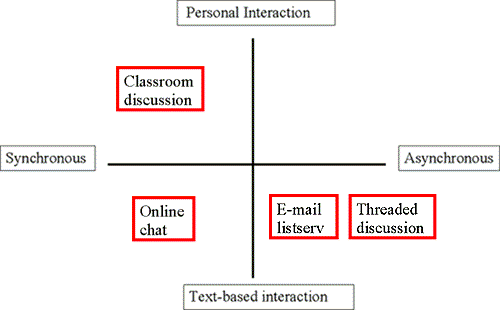Creating Distance Learning Courses
Lesson Three
Using Technology to Encourage Communication
The Discussion Forum Matrix
When comparing something as complex as educational methodology, it is sometimes useful to have a model or matrix in mind. Comparing endless lists of pros and cons of all these different formats might be mind-boggling (at best) and extremely boring (at worst). So, let me take you to the model first, and then use it to compare the characteristics of the different discussion formats.
Here is a two dimensional matrix of discussion formats. The horizontal line represents the "synchronicity" or timing of discussions, as I'll explain in a minute. The vertical line represents the nature of the interaction, whether it is a personal interaction or text-based only.

Look first at the horizontal line that divides the formats into 'synchronous"
(e.g. simultaneous or live) versus "asynchronous" (e.g. at any
time). Some discussions are done "live' or synchronously, for example
the classroom discussion and the online chat discussion. Everyone must
participate together and students who are not present simply do not benefit
from the discussion.
At the other end of the line are the "asynchronous' discussions, such as an listserv email and threaded discussion, where participants may contribute at any time that is convenient for them. In some cases, the discussions are so slow that participants can contribute any day or week that they choose. Students can take part in the discussion whenever it is convenient for them.
So, now let's place the format types in their appropriate position in the matrix.

You can see, that classroom discussions are very different from the other three formats. And live chat differs from listserv email and threaded discussions. Now let's look at the specific characteristics of these formats and their advantages and disadvantages.
